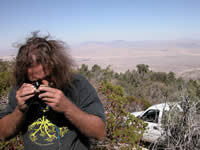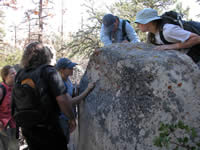USDA Forest Service Celebrating Wildflowers
|
|
|
 |
|
Lichen Collection and IdentificationCollectionTo collect lichens, first you must obtain permission to collect them from the landowner. Then it is on to collecting your specimens. It is not as easy as it sounds. Lichens grow slowly and take a long time to cover an area. You must be ethical when you collect. Please visit our Ethics and Native Plants web page for reasons to leave plants behind.
Remember that on National Forest Lands, it is illegal to collect vegetation without a permit. For collecting permit information on National Forests, please visit our Collection Permits web page. Identification
Identifying lichens is much more difficult than identifying vascular plants. Each lichen thallus is a complete microscopic world with unique characteristics separating it from the other lichens. Lichens are classified based on the fungus and fungal features. When identifying lichens, keep in mind that one species of fungus can have two different forms if paired with two different "photobionts". It is not common but it does happen. In order to identify lichen to species, lichenologists use common household chemicals and some not-so-common chemicals to test the color reaction of the unique compounds found in the structure of the lichen, as well as using a lichen key to distinguish between species. Although a few of the chemicals are common, such as bleach and iodine, others are not as easy to get and are costly and dangerous. However, just about anyone can use a botanical identification key and a hand lens to identify the genus of lichen and appreciate their collection.
Even if you are not interested in identifying lichens, they are still interesting and amazing organisms to look at with the naked eye as well as under a hand lens or microscope. Realizing the roles lichens play in our environment will give you a greater appreciation of the world around you. Lichen Identification Links
|
|
| NOTE: PDF format links require the Adobe Acrobat Reader to view. | |
| top | Disclaimers | FOIA | Privacy Policy | Quality of Information | Photo Credits & Use |
Location: http://www.fs.fed.us/wildflowers/interesting/lichens/identification.shtml
Last modified: Tuesday, 24-Jun-2008 21:54:36 EDT

